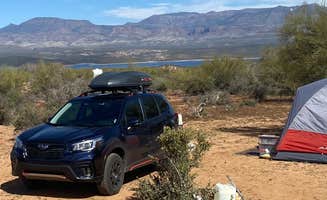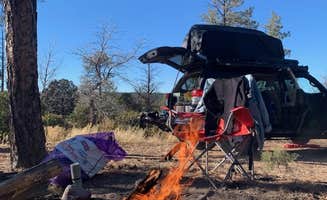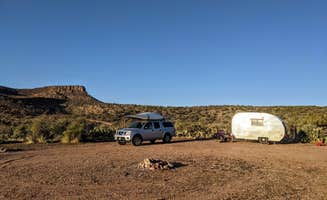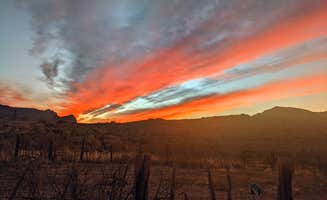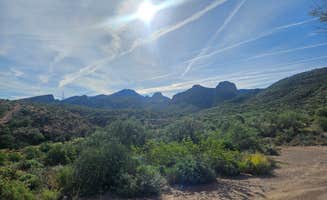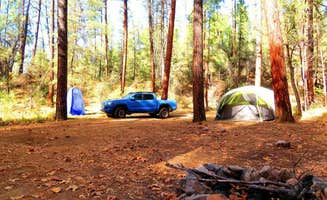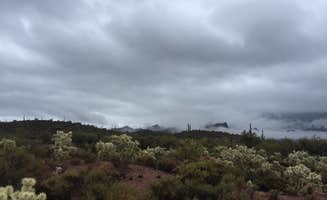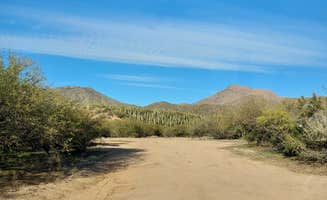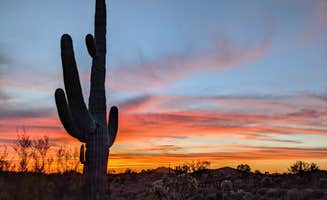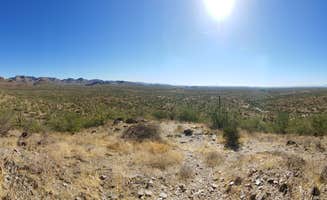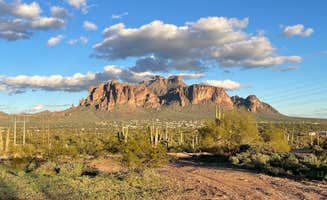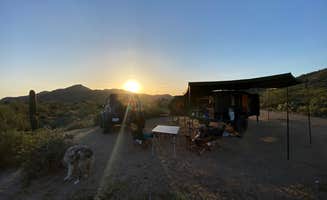Dispersed camping near Roosevelt, Arizona offers primitive desert camping experiences with opportunities for lakeside recreation and desert exploration. The area sits at approximately 2,200 feet elevation, with terrain transitioning from low desert to higher elevation pine forest in the surrounding Tonto National Forest. Winter overnight temperatures can drop below freezing while summer days frequently exceed 100°F, creating dramatic temperature swings that campers should prepare for.
What to do
Shoreline camping access: At Bermuda Flat Recreation Site, visitors can camp directly along Roosevelt Lake. "Great place to have a small or large group of people. Camping right on the shore," notes Ben L. This recreation area includes portable toilets and marked camping spots, though "you must have a Tonto pass to camp at these spots."
Wildlife watching: Desert wildlife viewing opportunities abound throughout the dispersed camping areas. At Tonto National Forest Dispersed Camping at Lake Roosevelt, campers report frequent wildlife encounters. "I heard coyotes in the middle of the night that woke me up, and was glad for a rooftop tent," shares Cas M. The desert landscape supports diverse bird species alongside mammals.
Hiking options: The Roosevelt area offers trails ranging from easy walks to challenging desert hikes. At Buena Vista Trailhead Dispersed, "The pin takes you to a trail head for an easy flat hike but drive up rim road to find these spots," explains Emma B. Most dispersed camping areas provide direct access to unmarked hiking routes through desert terrain.
What campers like
Established fire rings: Many dispersed sites feature existing fire rings for safe campfires. At A-Cross Road Dispersed Camping, campers find "Large flat spot for dispersed camping. Several other spots close by. Not much traffic on the road," reports scooter. Fire restrictions are common during dry periods, so check current regulations.
Sunset views: The combination of desert landscape and lake views creates memorable sunsets. "The sunrise and sunset here were spectacular, the lake provides an awesome blue," notes Finn L. about camping at Lake Roosevelt. The minimal light pollution also enhances stargazing opportunities after sunset.
Diverse vegetation: The Roosevelt area showcases classic Sonoran Desert plant communities. "Spent some time walking around checking out all the different cacti," shares Tanner P. about his stay at Tonto National Forest Dispersed Camping. Saguaro cacti dominate the landscape alongside various other desert plants, creating a distinctive camping backdrop.
What you should know
Temperature extremes: Desert camping brings significant temperature fluctuations between day and night. At EADS Wash, one camper experienced "freezing temperatures at night (long enough to form ice in our jugs of water) and low 80s during the day." Keith J. confirms: "We were there in the middle of January. Waking up to everything covered in frost was a pleasant surprise since it was around 70 during the day."
Water challenges: The Salt River contains high mineral content making filtration difficult. "We usually bring a water filter if we are camping by a river or stream, but this is the upper salt river and even when you filter it the water tastes extremely salty," reports Alex T. at Eucalyptus campground. No reliable potable water exists at most sites.
Road conditions: Access to many dispersed sites requires navigating unpaved roads. "The road is bumpy with some steep dips so I wouldn't advise it for low clearance vehicles," warns Emma B. about Buena Vista Trailhead Dispersed. Most campers recommend high-clearance vehicles for reaching the more secluded camping areas.
Tips for camping with families
Preparation for wildlife: When camping with children, prepare for potential wildlife encounters. "There are lots if Saguaro and jumping Cholla cactus around as well as rattlers and scorpions so be alert," advises a camper at Lake Roosevelt. Bring tweezers for cactus spines and review how to respond to desert wildlife sightings.
Site selection considerations: Choose camping locations thoughtfully with children. At Schoolhouse Point Dispersed, "Probably 20+ sites at each of the two pull offs, most have fire rings and decent shade," notes Cypress. Sites closer to facilities provide easier access to bathrooms for families.
Water recreation access: Roosevelt Lake offers swimming opportunities during hot weather. "Couple minutes drive to the boat ramp at schoolhouse Point which has bathrooms, dumpsters, and both drive in and walk-in lake access," reports Cypress about Schoolhouse Point Dispersed. Morning hours provide the most comfortable swimming conditions before afternoon heat.
Tips from RVers
Ground conditions: Desert terrain presents challenges for RV leveling and stability. At Superstition Mountains Dispersed Sites, campers note "The ground is very rocky and we couldn't find a great place to get a tent staked down in the windy conditions." RVers should bring extra leveling blocks for uneven terrain.
Access road considerations: RVers should scout roads before attempting access with larger rigs. "We took our 30 foot camper the 2 miles and boy was it insane off roading for a travel trailer! Don't recommend it as my tire exploded a week later probably from the abuse," warns a camper at Bulldog Canyon. Most Roosevelt area dispersed camping works best with smaller, more maneuverable RVs.
Water conservation: With no hookups available, water conservation becomes essential for extended stays. "No potable water even at the paid campground at the end of the road, you can either pump from the lake if you have a filter or Tonto national monument about 10min up the road has a water spigot before the pay gate," advises Cypress about Schoolhouse Point Dispersed.


